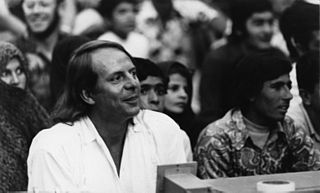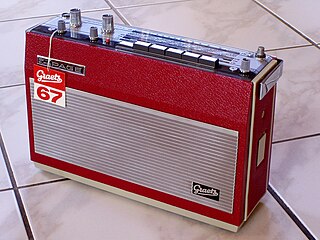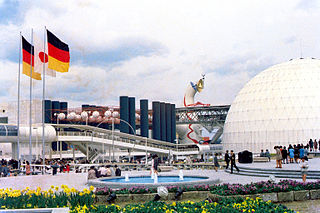
Ylem is a composition by Karlheinz Stockhausen for a variable ensemble of 19 or more players, and is given the work number 37 in his catalogue of compositions.

Ylem is a composition by Karlheinz Stockhausen for a variable ensemble of 19 or more players, and is given the work number 37 in his catalogue of compositions.
Ylem is "phoenix music", in that it represents the continual rebirth of the universe, according to the theory of the oscillating universe, which holds that the universe periodically explodes every 80,000,000,000 years. The title of the work is taken from the term ylem , a word used in medieval Latin, the accusative of the borrowed Greek term hylē (ὕλη, "matter"), and adopted in the 1940s by the physicists George Gamow and Ralph Alpher to refer to the essential material of the universe, in the context of the "Big Bang theory. [1] The subject of the composition is, in short, "the 'breath' of the universe". [2] The score is dedicated to the composer's son Simon, who was five years old at the time of composition. It was composed in December 1972 for a tour with the London Sinfonietta, who gave the premiere on 9 March 1973 under the composer's direction, at the Queen Elizabeth Hall, Southbank Centre, London. [3] The next evening, the same forces rehearsed and performed the piece on a live television broadcast from 10:50 to 11:30 pm on BBC2's Full House, hosted by John Bird, with questions from the studio audience and phoned in by viewers. Three studio recordings of this version were made on 21 March 1973 in the EMI Studios, London. [4]
The formal process of Ylem is notated verbally. [5] It requires a great deal of imagination from performers but is very simple in conception, consisting of the very slow attenuation and compression of a galaxy of musical points (Maconie 2005, 348). At the beginning, ten of the mobile performers stand close to the piano. After an initial explosive sound (on E♭ and A in the London version) these ten players move out into the hall, playing all the while, and take up positions around the audience, while the other players remain on the stage. This phase takes about eleven minutes, during which the players move their individual notes away from their starting pitches. At the same time, they diminish in volume and frequency of attacks, occasionally forming short melodic groups and increasingly are varied by trills and glissandos. [6] [5] Toward the end, the mobile performers return to the piano and a second explosion occurs, after which all nineteen players (the nine fixed-position players now switching to small portable instruments) disperse again through the hall and out of the building. [3] In the London recordings, this second explosion is a tone higher than the first. [6] The composer held that the music works best "when the players establish telepathic communication with one another (they play with closed eyes) and with a 'conductor' who listens with the utmost concentration from the middle of the hall, but does not take an active part". [3]
British journalists reviewing the world premiere expressed a mixture of bewilderment and scorn. Writing in The Times, Stanley Sadie said, "Criticism is impotent on such a work as this; there is nothing to do but describe". He nevertheless concluded by comparing Ylem unfavourably to earlier works by the composer on the programme ( Kreuzspiel , Zeitmaße , and Kontra-Punkte ), which "made his latest piece sound, rightly or wrongly, like Nirvana-hungry doodlings". [7] Paul Griffiths felt that the newest work on the programme, Ylem, "provided the least newness". Although "there was occasional interest in the responding calls across the hall … the overall process is simplistic—an idea that could well have been left to Xenakis". [8]
Where Sadie found contrasts to Stockhausen's earlier works, New Zealand composer and writer Robin Maconie perceives similarities: Spiel (1952), Gruppen (1955–57), Kontakte (1958–60), Momente (1962–64/69), the moment titled "Translation" in Mixtur (1964), Adieu (1966), the "Russian Bridge" in the Third Region of Hymnen with orchestra (1966–67/69), Intervall for piano four-hands (1969), and the Dr. K–Sextett (1969) all share with Ylem the technique of gradual dispersal or condensation (or both) of constellations of tones. [9] [10] [11]
American film and television critic David Lavery's response to what he calls "the strangest piece of program music ever composed" was more visceral:
When I first listened to Stockhausen's "Ylem", I was, at its close, nearly unable to move; the music seemed almost to have disintegrated my ordinary molecular structure, replacing it with its own aleatory form, and I waited a few moments before I attempted to move, as if I felt the need to reassemble my body. [2]
Explaining his personal reaction in the context of a recurring childhood nightmare of nothingness, Lavery invokes a similar idea underlying H. P. Lovecraft's short story "The Music of Erich Zann" and sensations described in passages from Georges Poulet, Rainer Maria Rilke, Herman Melville, Claude Lévi-Strauss, Paul Valéry, R. Murray Schafer, and the Śūraṅgama Sūtra . Finding that Ylem represents the Vedic "unstruck sound of the celestial realm" or anahata nad, Lavery concludes that it is representative of Stockhausen's moment form, "music made out of nothing, one of Stockhausen's most effective attempts to create a 'sequence of silences'". [12]

Momente (Moments) is a work by the German composer Karlheinz Stockhausen, written between 1962 and 1969, scored for solo soprano, four mixed choirs, and thirteen instrumentalists. A "cantata with radiophonic and theatrical overtones", it is described by the composer as "practically an opera of Mother Earth surrounded by her chicks". It was Stockhausen's first piece composed on principles of modular transposability, and his first musical form to be determined from categories of sensation or perception rather than by numerical units of musical terminology, which marks a significant change in the composer's musical approach from the abstract forms of the 1950s.

Aus den sieben Tagen is a collection of 15 text compositions by Karlheinz Stockhausen, composed in May 1968, in reaction to a personal crisis, and characterized as "Intuitive music"—music produced primarily from the intuition rather than the intellect of the performer(s). It is Work Number 26 in the composer's catalog of works.

Kurzwellen, for six players with shortwave radio receivers and live electronics, is a composition by Karlheinz Stockhausen, written in 1968. It is Number 25 in the catalog of the composer’s works.
Adieufür Wolfgang Sebastian Meyer is a composition for wind quintet by Karlheinz Stockhausen composed in 1966. It is Number 21 in the composer's catalog of works, and the second of Stockhausen's three wind quintets.

Spiral, for a soloist with a shortwave receiver, is a composition by Karlheinz Stockhausen, written in 1968. It is Number 27 in the catalogue of the composer's works.

Mixtur, for orchestra, 4 sine-wave generators, and 4 ring modulators, is an orchestral composition by the German composer Karlheinz Stockhausen, written in 1964, and is Nr. 16 in his catalogue of works. It exists in three versions: the original version for full orchestra, a reduced scoring made in 1967, and a re-notated version of the reduced scoring, made in 2003 and titled Mixtur 2003, Nr. 162⁄3.
Prozession (Procession), for tamtam, viola, electronium, piano, microphones, filters, and potentiometers, is a composition by Karlheinz Stockhausen, written in 1967. It is Number 23 in the catalogue of the composer’s works.

Pole (Poles), for two performers with shortwave radio receivers and a sound projectionist, is a composition by Karlheinz Stockhausen, written in 1970. It is Number 30 in the catalogue of the composer's works.

Atmen gibt das Leben, is a choral opera with orchestra by Karlheinz Stockhausen, written in 1974 and expanded in 1976–77. It is Number 39 in the catalogue of the composer's works, and lasts about 50 minutes in performance.

Punkte (Points) is an orchestral composition by Karlheinz Stockhausen, given the work number ½ in his catalogue of works.
Formel (Formula) is a composition for chamber orchestra by Karlheinz Stockhausen, written while he was still a student in 1951. It is given the number 1⁄6 in his catalog of works, indicating that it is amongst the pieces preceding the composition he recognised as his first mature work, Nr. 1 Kontra-Punkte.

Stop is a composition for orchestra by Karlheinz Stockhausen, work-number 18 in the composer’s catalogue of works, where two performing realisations are also found as Nr. 18½ and Nr. 18⅔.

Expo, for three performers with shortwave radio receivers and a sound projectionist, is a composition by Karlheinz Stockhausen, written in 1969–70. It is Number 31 in the catalogue of the composer's works.
Schlagtrio is a chamber-music work for piano and two timpanists composed by Karlheinz Stockhausen in 1952. It is Nr. ⅓ in his catalogue of works.
The Dr K–Sextett is a short, occasional composition for six instrumentalists, written in 1969 by Karlheinz Stockhausen and given the number 28 in his catalogue of works.
A Garland for Dr. K. is a set of eleven short compositions created in 1969 for the celebration of the eightieth birthday of Dr Alfred Kalmus, the director of the London branch of Universal Edition. It is also the title of an album containing these eleven pieces of music, recorded in 1976.

The Sonatine (Sonatina) for violin and piano is a chamber music composition by Karlheinz Stockhausen, written while he was still a student in 1951. It carries the work-number ⅛ in his catalogue of works.
Drei Lieder, for alto voice and chamber orchestra, is a song cycle by Karlheinz Stockhausen, written while he was still a conservatory student in 1950. In the composer's catalogue of works, it bears the number 1/10.
Spiel is a two-movement orchestral composition by Karlheinz Stockhausen, written in 1952. Withdrawn by the composer after its first performance, it was later revised and restored to his catalogue of works, where it bears the work-number ¼. The score is dedicated to the composer's first wife, Doris.

Europa-Gruss is a composition by Karlheinz Stockhausen for wind ensemble with optional synthesizers, and is assigned Number 72 in the composer's catalogue of works. It has a duration of about twelve-and-a-half minutes.